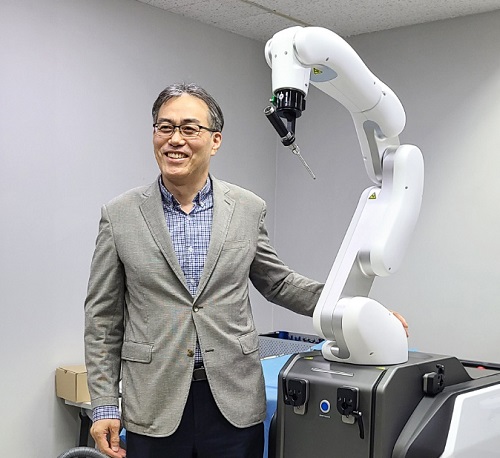ㆍ From surgical robots to rehab robots… commercializing medical robots built with distinctive technology
ㆍ Accomplished steady results by a detailed approach like finding strategic partners
ㆍ “We will develop inroads to overseas markets such as the United States for stable sales”

"The medical robot market has already become competitive. To survive in it, you have to make a good choice in what you're going to target."
From orthopedic surgical robots to rehabilitation robots, there is a company that has succeeded in commercializing medical robots developed with their own technology, revitalizing medical sites in the country and abroad. It is a South Korean medical robot company called Curexo. It maintained the pride of domestic surgical robots by supplying various medical robots developed by its distinctive technology despite the COVID-19 pandemic last year. Meet Lee Jae-jun, CEO of Curexo, and hear about details.
- Why did you choose orthopedic surgical robots among many medical robots?
The orthopedic surgical robot market grabbed my interest. Just in time, the medical robot business division of Hyundai Heavy Industries, which Curexo acquired in 2017, has been researching and developing joint surgery robots. Based on the technology we have accumulated, we were confident we will be able to overcome the technology gap with other robots and settle in the market faster. As the demand for orthopedic surgical robots is expected to continue to increase due to the aging population, we will accelerate product research and development and differentiation.
- Curexo has achieved remarkable results even amidst the COVID-19 situation.
Last year, we focused on actively selling various medical robots of Curexo not only in Korea but also abroad. Thankfully, We met many good partners and were able to supply a total of 18 medical robots (13 in Korea and 5 overseas), including 8 artificial joint surgery robots "CUVIS-joint", 3 spinal surgery robots "CUVIS-spine", 5 lower extremity rehabilitation robots "Morning Walk," and 2 upper extremity rehabilitation robots "InMotion."
- It would've taken a lot of effort to step in among foreign surgical robots. Tell us about the success strategy.
I focus on three major strategies: choosing business areas, differentiating technologies, and finding strategic partners. Considering whether the market has a bright growth outlook and whether it will perform well in the market with our technology, orthopedic surgical robots were the most suitable target in many means.
However, lubricants were needed to efficiently enter the domestic and foreign markets. Therefore, we focused on finding strategic partners to join us in entering the market. Implants are almost always necessary for orthopedic surgeries, so the first target was the implant companies. "Wouldn't you be more likely to see better results if you join the surgical robot?" and this strategy worked.

- It seems like Curexo's medical robots are easy to handle and not burdensome. What did you focus on when developing them?
While emphasizing the existing advantages of medical robots such as accuracy and precision, we focused on minimizing the actual burden on medical staff and patients in terms of price, size, and convenience.
For example, the artificial joint surgical robot "CUVIS-joint" was developed to reduce the preparation time for robotic surgery with simple calibration and designed small to take less space in the operating room.
The spinal surgical robot "CUVIS-spine" leads the surgical tool to the target position with only two C-arm (2-dimensional) images, allowing accurate insertion of the spinal cord screw. The patient's position can be monitored live and the surgery plan can be modified, allowing easier and more suitable ability than other robots.
The lower extremity rehabilitation robot "Morning Walk" is a sitting weight support method that allows patients to easily board and start training within a minute. During training, you can set the level of walking speed and stride according to your ability, so children and adults can do rehabilitation training without much difficulty.

- Expectations are high as a number of licenses are expected to be approved this year. What is the specific licensing schedule?
The artificial joint surgery robot "CUVIS-joint" is soon to be approved by Europe CE and spinal surgery robot "CUVIS-Spine" by the U.S. FDA. The walking rehabilitation robot "Morning Walk S200," which is scheduled to be released as a new product, is being reviewed by European CE and domestic MFDS and is expecting to obtain a license in the first half of this year.
- Tell us about the new year's activities. What kind of goals are you going to lead this year?
If the COVID-19 situation improves, we would like to show the market the true value of Curexo through exhibitions and live demonstrations. The biggest goal of this year is to build a stable sales network overseas through this. We will continue to activate our sales networks in foreign markets such as India and Australia and especially target large markets such as the United States.
- The story of Curexo is likely to bring hope for other domestic robot companies. Please tell us your determination.
If you take the first step on which field to target and differentiate the product technically or price-wise, domestic surgical robots will also advance in the market. In the future, Curexo will serve as a strong cornerstone for the growth of the domestic surgical robot market by creating many hopeful results. Please continue to support Curexo's actions.


